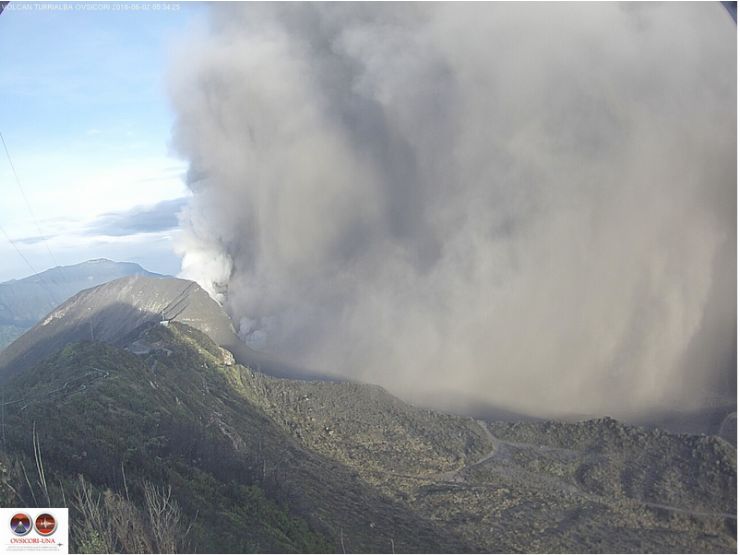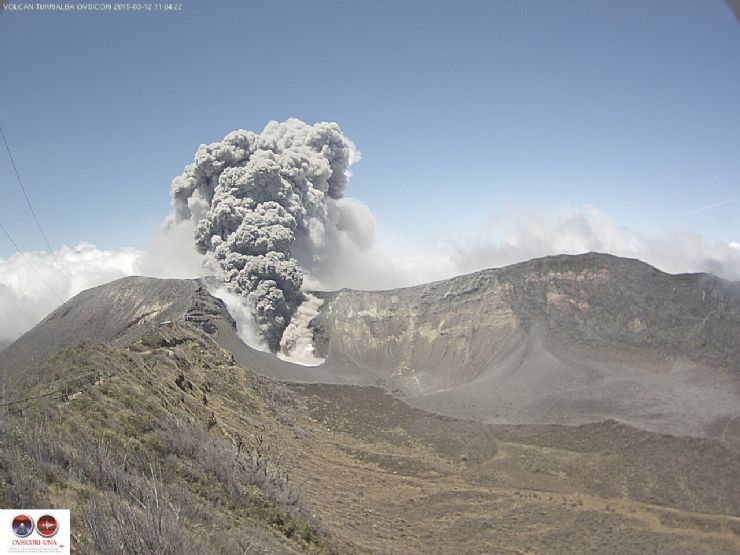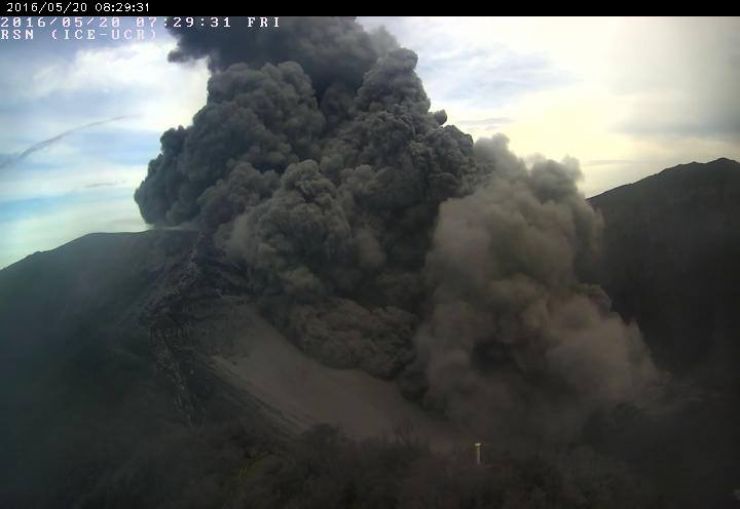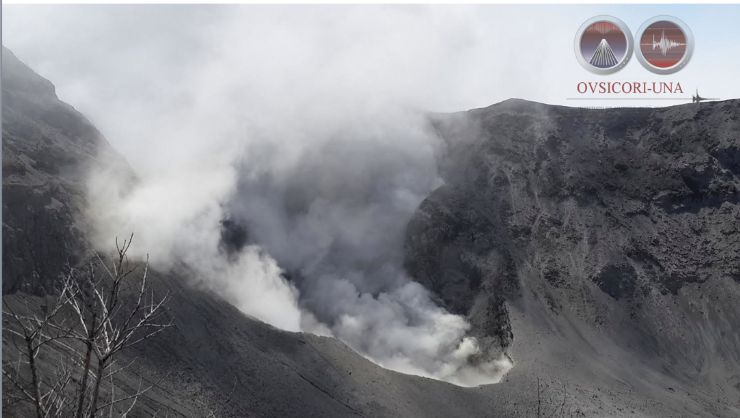
June 2nd Big Eruption (Ovsicori UNA)
Costa Rica is an amazing country that draws not only year-round tourists, but also scientists. Archeologists, geologists, and volcanologists travel to Costa Rica from all over the world to study the beautiful, natural landscape of my home. One of the reasons that volcanologists are so drawn to Costa Rica is because the country’s bountiful national parks and reserves are home to more than sixty volcanoes. That’s right, there is a great number of glorious towers (some dormant or extinct) raising about the earth here in my home. Volcanologists come here so that they can study these volcanoes, in the hopes of finding out more about what makes them erupt. The hope for these studies is that the knowledge gained can help scientists find a way to better predict eruptions, and ultimately save lives.
This type of predictive modeling could prove to be useful in the near future, especially with all of the recent activity of the Turrialba Volcano. Turrialba is an 11,000 foot tall strato volcano that can be found in the region with the same name, Turrialba in Cartago, about 50 kilometers to the east of Costa Rica’s capital city, San José. The area is typically one that is teeming with tourists and scientists, who have long celebrated the volcano’s craters. Now, though, scientists are visiting the area for a different reason: to help learn enough that to predict if, and when, the volcano might erupt and put nearby towns, including San José, in eminent danger.
.jpg)
Turrialba Volcano Erupting
Current Activity at Turrialba
Starting in 2014, Turrialba has been an active area. So active, in fact, that the area has been closed to tourists. The question that everyone is asking is if this is just a tantrum, or if the volcano will throw a fullon, real, dangerous fit. Are these small eruptions as bad as it will get, or is a scary eruption in the near future? Though activity has ebbed and flowed over the last few years, residents, law enforcement, and volcanologists are still voicing their concerns, especially after explosions picked up again in April. The eruptions can be very scary to witnesses, since they can last for several hours at a time. There have been several tremors reported since the volcano started to wake up, and those are a result of the explosive eruptions. These tremors are mostly small, but up wards of 200 have been reported in a single day. The eruptions haven’t just caused tremors, either. They have also caused a blanket of ash to be dropped onto some of the areas that surround the volcano. There are also unseen effects of these eruptions, including the fumes that are released into the atmosphere. The gas plumes have been reported as high as 3km. The most recent series of explosions at Turrialba, as reported to the Red Sismológica Nacional (National Seismological Network), detail eruptions and plumes with only hours, or just minutes, separating them. It has even been recorded that these explosions, though periodic calm periods, can last for up to 75 hours at a time.
Most recently, the volcano has been consistently active, with detectable tremors and ash. Ash is being reported on two additional provinces: San Jose and Heredia, depending on the wind conditions at the time of the eruptions. There are areas where ash is accumulating, and in other areas is it present but not accumulating. There has been some recent rain in the affected areas, and that has helped to remove some of the material that has been deposited by the volcanic eruptions. While access to the Turrialba Volcano area has been limited since 2014, the restricted area was recently extended as a result of the activity. There haven’t been airport closings reported as of now, but some flights have been impacted with delays or cancellations. Right now, Turrialba Volcano is under active yellow caution alert.

March 12th Ash Eruption (Ovsicori UNA)
7 Days / 6 Nights
Starting at $779 per person
Misinformation
As with anything in the information age, it is easy for a lot of misinformation to be spread. If you are planning on visiting the area, it’s important that you research current news from credible sources, including local Costa Rica news outlets. Random postings on Facebook or other social media are not a good place to gather your information, as it just isn’t credible. A few rumors about Turrialba have already begun to spread, and these rumors can cause panic. Refrain from sharing stories that you can’t credit, and research anything you see to discover if it is true or not. One rumor that is going around is that a group of Japanese geologists were trying to warn the people of Costa Rica that a “big one” was coming, but they were silenced. Sounds like the plot of a movie, right? Well, the Tico Times Newspaper debunked this rumor. Someone claimed that the scientists spoke of a devastating earthquake, and were removed from Costa Rica by the country’s government. This rumor was debunked by volcanologists that say that the potential of Turrialba could result in smaller earthquakes, but that a “big one” wasn’t in the scope of the volcano’s activity. There just isn’t enough magma inside of the volcano for that much pressure to be released. Reports that lava has been seen in craters are exaggerated, and false. The other thing you need to be very wary of is images that are posted with captions suggesting the images are Turrialba. In most cases, the image are not even Turrialba, they are images of other volcanoes from around the world that have erupted in the past. As mentioned, airports are still open but some flights might be affected. If you are traveling to, or within, Costa Rica now or in the near future, you should check the airports’ websites, or call them, for the most recent and accurate information.
Effects of an Active Volcano
While airports haven’t been impacted yet, it is always a possibility. Since the air can be impacted and the visibility affected by ash from eruptions, it’s best that you are not in the air when it is deemed unsafe. Some flights have experienced delays or cancellations, but overall travel is still active in the area. Airlines that have experienced disruption as a means of caution include Southwest, Air Canada, Spirit, United, and Aeromexico. Some airlines have even recently rerouted flights originally scheduled to land at Juan Santamaría International Airport to Daniel Oduber International Airport in Liberia, Guanacaste instead. The delays, cancellations, and reroutes are at the discretion of the airlines at this time, as there is no official alert for the ash from the volcano.
Some of the explosions and the accompanying ash have resulted in power outages as well. Sometimes this even has an impact on the environmental equipment that is measuring the activity. Because of the restriction on access to the area, crews aren’t always allowed to get close enough to repair broken equipment. Another effects of an active volcano is that population is decreased. With reduced or sometimes cancelled flights, the economy will feel the impact. If less people are able to visit the country, there will be less tourist dollars being spent. The area around the volcano has already been closed off to the public since 2014, which is one less place for people to visit in the country. There are also less tourists visiting Costa Rica and using the country’s hotels, adventure businesses, water sport equipment, and bars. There are also issues with farming. The ash that is falling in Central Valley communities on the provinces of San Jose, Cartago, Heredia, and Alajuela is ruining crops, and reducing the output of some commodities, including milk. As the production of farming commodities is affected, it will impact food supply and the restaurant business. Animals, hay, and crops are all being evaluated for visible effects from the ash. Some crops that could be impacted include potatoes, flowers, yuca, carrots, cabbage, and beets. Some predictions say that up to 50% of the year’s crops could be affected by the volcanic ash that is spreading in the wind and being deposited onto farms.
Ash is also falling on people’s homes. Roofs are being visibly covered with ash. While this might seem like an opportunity to take a photo for social media, there are some very real health concerns associated with this ash. Those in affected areas should wear masks and goggles when possible to prevent breathing and vision problems. Another impact of an active volcano that is often overlooked is education. If the eruptions and ash effect an area where a school is located, classes may have to get cancelled for an extended, or even indefinite, period of time.

May 20 Big Ash column (Red Sismologica Nacional)
Staying Safe in the Vicinity of an Active Volcano
The most important thing to remember about being in the vicinity of an active volcano is to stay safe. It might be a really awesome, once-in-a-lifetime experience, but you need to keep a distance and follow local restrictions and regulations. If law enforcement asks you to evacuate or to wear a mask, just do it. Don’t be the person that is staying behind and causing potential hazards just because they want to take a selfie with an erupting volcano.
While a lot of the information that is being spread on social media is false, that doesn’t mean that there is no reason to be cautious. If you are staying in any of the areas near Turrialba, you should be prepared for an emergency. You should make sure that you have access to clean drinking water. If you are staying at a hotel long term, stock up on water. If you are on the go, make room in your bag for extra water, and keep restocking. Whether you are traveling often or staying put, you want to have some nonperishable food on hand, and you want to have access to as many emergency supplies as possible, like a flashlight and a first aid kit. You should also speak to hotel staff or locals about what the standard emergency escape route would be. If you encounter ash that you need to clean up yourself, do so with a wet cloth. Travelers should also pack, or purchase upon arrival, long pants and shirts. These clothes help cover the skin against the volcanic ash, which is not healthy.

Amazing crater view of Turrialba Volcano (Maria Martinez)
The History of Turrialba
Turrialba has not been a quiet volcano in the most recent years. A beautiful landscape in the Turrialba National Park, this 11,000foot volcano in Cartago province was once an area where visitors could hike and explore. There are sulfur pits at the summit, and craters that were always crowded with tourists and the curious locals. The volcano spent about 150 years being inactive, with no eruptions or lava flows. Then, in the 1990's, some activity was reported. The 2000's were more or less the same, with some activity being reported, but no explosions, eruptions, lava, or ash. Then, in 2010 there was an eruption that resulted in the evacuation of communities that were in the immediate vicinity. After that though, the volcano was not doing anything reportable.
While still being monitored, it was considered less and less of a risk. The 2014 eruption, though, was by far the worst that we have seen, and the strongest in over a century. The volcano has remained active ever since, and has been closed to the public. No more can visitors hike around or explore the craters. For the safety of the general public, the area will have to be cleared by the government of Costa Rica before anyone is allowed in the area. This multi year activity log, which started in 2010, has continued into 2016, and while residents are concerned, there is some excitement in the geology and seismology communities. Volcanic eruptions remain unpredictable to this day, but the study of active volcanoes help the experts learn more. Hopefully the information that they are able to gather can help them predict how, why, and when volcanoes might erupt in the future, including Turrialba. In the meantime, Costa Rican residents, government, and guests, along with visiting scientists, have the incredible experience of seeing nature in its rarest and rawest form.
For GoVisitCostaRica.com this was Javi the Frog on location. I'll keep you updated, promess

